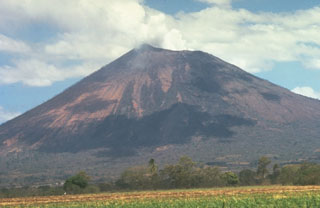Report on San Cristobal (Nicaragua) — 12 September-18 September 2012
Smithsonian Institution / US Geological Survey
Weekly Volcanic Activity Report, 12 September-18 September 2012
Managing Editor: Sally Sennert.
Please cite this report as:
Global Volcanism Program, 2012. Report on San Cristobal (Nicaragua) (Sennert, S, ed.). Weekly Volcanic Activity Report, 12 September-18 September 2012. Smithsonian Institution and US Geological Survey.
San Cristobal
Nicaragua
12.702°N, 87.004°W; summit elev. 1745 m
All times are local (unless otherwise noted)
On 10 September, INETER reported that seismicity decreased after the 8 September eruption at San Cristóbal. Sulfur dioxide emissions had decreased since the previous day. During 10-11 September steam plumes rose 200-300 m above the crater and drifted W. Three small explosions on 11 September generated ash-and-gas plumes that rose 300 m above the crater and drifted W. An explosion and ash venting was observed a few hours later; a plume drifted S and ash fell on the flanks. The seismic network detected small explosions on 13 September. Sulfur dioxide gas emissions were above normal, and similar to levels detected on 8 September. Sulfur dioxide gas emissions increased on 14 September. The next day a small explosion was observed and gas plumes drifted NE. Gas plumes drifted N on 17 September.
Geological Summary. The San Cristóbal volcanic complex, consisting of five principal volcanic edifices, forms the NW end of the Marrabios Range. The symmetrical 1745-m-high youngest cone, named San Cristóbal (also known as El Viejo), is Nicaragua's highest volcano and is capped by a 500 x 600 m wide crater. El Chonco, with several flank lava domes, is located 4 km W of San Cristóbal; it and the eroded Moyotepe volcano, 4 km NE of San Cristóbal, are of Pleistocene age. Volcán Casita, containing an elongated summit crater, lies immediately east of San Cristóbal and was the site of a catastrophic landslide and lahar in 1998. The Plio-Pleistocene La Pelona caldera is located at the eastern end of the complex. Historical eruptions from San Cristóbal, consisting of small-to-moderate explosive activity, have been reported since the 16th century. Some other 16th-century eruptions attributed to Casita volcano are uncertain and may have been from other Marrabios Range volcanoes.
Source: Instituto Nicaragüense de Estudios Territoriales (INETER)

